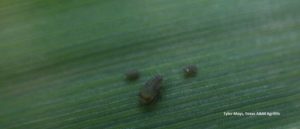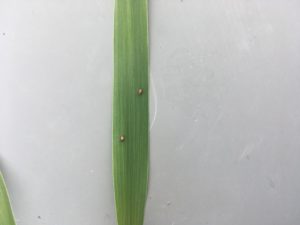By John Few, Tyler Mays, and David Drake – Texas A&M AgriLife Extension Agents – IPM Thrall, Hillsboro, and Commerce TX
Rhopalosiphum padi commonly known as Bird cherry oat aphid (BCOA) is an insect pest of cereals and grasses that is readily appearing now in oat and wheat fields in Texas. This insect is usually described as being pear-shaped, yellow-green, dark green, or black in color with red coloration at the base of its abdomen near the cornicles (Image 1). While feeding from this pest usually does not cause economic damage, it is an efficient vector for barley yellow dwarf virus, a disease known to cause economic loss in wheat. Large populations of BCOA can also reduce the plant’s ability to photosynthesize by creating an environment for sooty mold via the sticky honeydew they produce while feeding. There are a few practices that can be done to control BCOA.
One method suggested by Oklahoma State University and Oklahoma Cooperative Extension Service is to scout for parasitized or “mummy” aphids. See Image 2. These aphids are usually tan in color. These aphids are being killed by parasitic wasp that can help prevent or reduce the amount of insecticide that you have to spray. To determine if parasitic wasp are adequately controlling populations in your field collect 25 tillers and count the number of mummy aphids. If you see mummies on 7 of the 25 plants then do not spray as the other aphids are most likely parasitized as well. If this is not the case the additional scouting is needed.
To determine an economic threshold in your field, start by counting the number of aphids on 25 tillers. Once that number is obtained follow the flow chart below to determine if you need to make an insecticide application.
Step 1. Estimate yield loss: Total # of aphids:________= average # aphids/tiller ________ /25
Yield loss estimate: =0.00 if aphid counts are <20 per tiller,
0.05 if aphid counts are 20-39 per tiller,
0.09 if aphid counts are ≥ 40 per tiller
Step 2: Estimate Crop Value $________ /acre
Yield potential/acre #________ bushels/acre X value of grain per bushel $________ per bushel
= Crop Value $________ per acre
Step 3: Estimate Control Cost $________ /acre
Insecticide cost $________ /acre + Application Cost $ ________ /acre
= Control Cost $ ________ /acre
Step 4: Estimate Preventable Loss
Crop Value/acre $ ________ X Yield Loss from aphid $ ________
= Preventable Loss $ ________
IF Preventable Loss $________ is greater than Control Cost $________ TREAT
IF Preventable Loss $________ is less than Control Cost $___________ DON’T TREAT
Table 1. shows a method developed by the University of Nebraska Lincoln to determine action thresholds for BCOA by plant growth stage. While these methods are not from Texas A&M and have not been fine tuned for Texas’ environment, they are better than not scouting at all or having economic loss by missing an application window.
The following are insecticides approved to control BCOA: Baythroid 2, Di-Syston 15% G, Dimethoate Dimate, Lorsban 4E, Nofos 4E, Methyl 4EC, Mustang Max, Penncap-M, Proaxis, Thioanex 3EC, Malathion 8, Dimethoate 4EC, and pyrethroids. Apply insecticides according to the label.
Table 1. Action threshold for BCOA
| Average # of BCOA per stem needed to meet threshold | |||||
| Species | Seedling | Boot to Heading | Flowering | Milky Ripe | Milk to Medium Dough |
| Bird cherry-oat aphid | 20 | 30 | >5 | 10 | 10 |
References to thresholds
OSU: http://entoplp.okstate.edu/pddl/pddl/2005/PDIA4-6.pdf/
UNL: https://cropwatch.unl.edu/insect/wheataphids

John Few
Stiles Farm-IPM Extension Service
Texas A&M AgriLife Extension Service
john.few@ag.tamu.edu
985-817-2260

